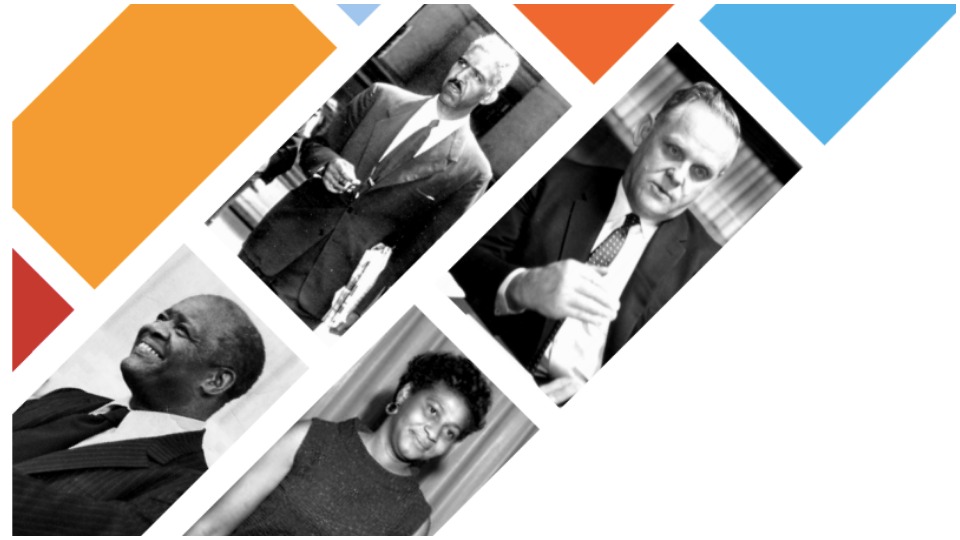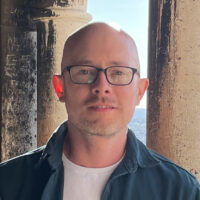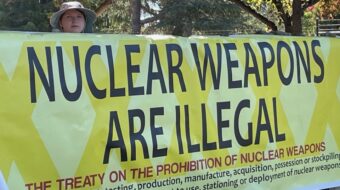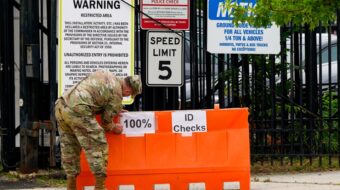
Many mainstream historians concluded long ago that the Communist Party USA, which was the predominant left organization in the United States during the years of the Great Depression and World War II, basically died out after the Red Scare. The end of the Cold War and the fall of the Soviet Union just reinforced that idea even more.
A new collection of biographies of CPUSA leaders from the second half of the 20th century is pushing back against that narrative and challenging the received wisdom that the Communists were just a marginal force following the repression of McCarthyism.
People’s World interviewed author Tony Pecinovsky to discuss his book, Let Them Tremble: Biographical Interventions Marking 100 Years of the Communist Party, USA, from International Publishers. In our conversation, Pecinovsky outlines the thinking which went into his research and he places the book within the field of American Communist history.
People’s World: You’ve titled the book, “Let Them Tremble,” which many will recognize as a throwback to the closing lines of Marx and Engels’ Communist Manifesto. Why is now a good time for a new book on the Communist Party USA? What is it about this party that has “made the ruling classes tremble” for all these decades?

Tony Pecinovsky: As far as the first part of the question, now is a good time precisely because 2019 marks the 100th anniversary of the birth of the Communist Party USA. It is a historic moment. How many organizations get to be 100 years old? It is a real accomplishment. That the CPUSA is able to celebrate its 100th anniversary at all is a testament to the resiliency and determination of its members despite an unparalleled level of political repression through the McCarran and Smith Acts, and McCarthyism generally. Additionally, with the increased interest in socialism today, it is important for people—particularly young people—to understand the CPUSA’s contributions to democracy, peace, workers’ rights, equality, and socialism.
As far as the second part of the question, as I discuss in Let Them Tremble, the ruling class acted out of fear and weakness in its attempt to isolate and destroy the Communist Party. In hindsight, the attacks levied against Communists can easily been seen as acts of desperation. The ruling class was particularly fearful of a post-war emerging Black militancy comfortable with red allies, a partnership that wasn’t afraid to align with ascending world socialism, a partnership that compelled concessions from capitalism and imperialism. These concessions weren’t just handed out. They were forced. They were compelled. Fear of an emerging socialist world of which the CPUSA was a part compelled these concessions.
There must be hundreds, or even thousands, of CP personalities and grassroots figures who could have been considered for a project like this. The people highlighted in the book range from local leaders all the way up to national figures. What was the thinking behind the choices of people you cover?
So, Let Them Tremble is a collection of six short biographies, roughly 20,000 words each. The subjects are: Arnold Johnson, Charlene Mitchell, Gus Hall, Henry Winston, Judith LeBlanc, and W. Alphaeus Hunton. Each biography is centered on two or three themes. The lives of the Communists discussed in Let Them Tremble are centered around these themes. For example, Charlene Mitchell’s life is centered around her bid as the first African-American woman to run for president of the United States in 1968, the birth and work of the National Alliance Against Racist and Political Repression, and the struggle against Reaganomics. W. Alphaeus Hunton’s life is centered around his work in the National Negro Congress, the Council on African Affairs and Black liberation generally.
My goal is multifaceted. First, I am telling a political story. Second, I am moving the historical narrative forward, past 1956. Third, I am demonstrating the continued role of Communists in various movements—peace, youth and students, the struggle for African-American equality, national liberation, against political repression, for independent media, etc. Fourth, I am demonstrating the continuity of struggle from the 1930s, ’40s, and ’50s into the 1960s, ’70s and ’80s, and in Judith LeBlanc’s chapter, into the 2000s. Fifth, I am challenging the dominant myth within much of historiography that the CPUSA became a marginal force after 1956.
The logic behind the biographical choices is simple: Who had a compelling story to tell? And how best do I tell that story? Or, how best do I tell that story within the confines of roughly 20,000 words. Of course, there are as you indicate hundreds, if not thousands, of CPUSA personalities who could have been considered, and many were. But ultimately, I had to settle on six. However, that is not to say that other prominent CPUSA personalities are not part of the project. Lives intersect. The biographies in Let Them Tremble do not exist in isolation. So, other CPUSA personalities interact and are a part of the biographical narrative.
The book’s focus is on the post-1956 period. Of course, with the Stalin revelations and the Hungarian uprising that year, it was a pivotal year for Communists around the world. How did things change for the CPUSA after 1956?
Well, a number of things changed for the CPUSA after 1956. There was an “internal crisis.” There had been nearly a decade of political repression. Membership had fallen dramatically. The CPUSA was undoubtedly weakened.
However, my focus isn’t so much on how things changed for the CPUSA. The CPUSA continued as a political force, a potent political force, in fact. My focus post-1956 is meant as a challenge to the dominant, traditional historiography which argues that the CPUSA was a “shattered organization” “afflicted with a mortal illness” that became a marginal force after 1956 as its “membership plummeted.” This is the traditional narrative, the dominant perspective. The overarching goal of Let Them Tremble is to challenge this narrative, which each biography does in one form or another. I acknowledge that the CPUSA was weakened after 1956. However, I don’t agree—and the historical record does not substantiate—the argument that the CPUSA was a marginal political force after 1956. That argument just doesn’t square with the historical record.
Even for those readers who might be relatively up to speed on their radical U.S. history, some of the personalities you cover in the book are certainly among the less-well-known. How challenging was it to be the first to take up the task of detailing their lives?
It was very much a challenge, albeit a fun and rewarding one. It led me down so many wonderful historical corridors and pathways. The personalities explored in Let Them Tremble are so inspiring, so full of humanity. It was a real honor to read through the personal letters, correspondence, and notes housed at NYU’s Tamiment Library. The CPUSA documents housed there are really a treasure. Hopefully, a new generation of historians will look with fresh eyes at the collection donated by the CPUSA about a decade ago and begin to rewrite the history from a more sympathetic perspective.
Of special note to me were the personal letters between Arnold Johnson and his wife during the height of the Red Scare. They had every reason to be despondent, to be fearful. However, in letter after letter, optimism shines through, a hope that the prevailing winds of Red Scare would soon shift back toward democracy. Mind you, these were personal letters. They weren’t meant for public consumption. They were soft, caring moments shared between partners during the darkest days of McCarthyism. Yet, despite the repression—the FBI surveillance, harassment and intimidation, the jailing of their friends and comrades—they were optimistic. Johnson believed so strongly in the Bill of Rights, in democracy. And that faith shines through in every document, in every letter.
In the past, especially during the Cold War era and then again around the time the Soviet archives opened up in the 1990s, there were many historians and political scientists who published books and articles on different aspects of the Communist Party in the United States. What is the state of the field these days?
There has been a shift toward more sympathetic accounts in recent years. Historian Gerald Horne’s biographies of William L. Patterson, Benjamin Davis, Jr., Paul Robeson, Shirley Graham DuBois, and Ferdinand Smith, for example, come to mind. Sara Rzeszutek’s biography of James and Esther Cooper Jackson, and Gary Murrell’s biography of Herbert Aptheker is also worth noting.
There have been some good general histories, as well. Chicano Communists and the Struggle for Social Justice by Enrique M. Buelna, Death Blow to Jim Crow: The National Negro Congress and the Rise of Militant Civil Rights by Erik S. Gellman, and Robert Zecker’s “A Road To Peace And Freedom”: The International Workers Order And The Struggle For Economic Justice And Civil Rights, 1930-1954, are really great examples.
But more needs to be done. A “red taboo” still exists in U.S. historiography obscuring the contributions of Communists and/or those who worked with Communists. Let Them Tremble is a sincere attempt to enlarge the historical lens, to bring the historical narrative forward, to discuss the work of Communists in the post-1956 period.
As author of a study like this one, you don’t come from a traditional “ivory tower” background. How do you think crossing the lines of activist-researcher-historian shaped the type of book you’ve produced?
I definitely do not come from a traditional “ivory tower” background. My formal education is actually very limited. After graduating high school, I completed a couple of semesters at the local community college, mostly studying history and economics. However, my formal education stops there.
I went from being a student to student activism. I went from student activism to union organizer. I went from there to the Communist Party. I’ve been in the grassroots of political activism my entire adult life. That perspective, those experiences, have undoubtedly impacted my researching and writing of history. I remain unapologetically partisan to the working class. As such, I focus on the grassroots of political activism in the biographical narratives explored in Let Them Tremble.
So we understand that you’ve already started a speaking tour to promote the book. What’s been the reception so far and where else can people catch you discussing it? And even more importantly, when and how can readers get a copy of the book?
The reception has been very positive. Students as well as other historians are genuinely interested in this project. Some of the research was presented at the 2019 Organization of American Historians Conference. I’ve made presentations at the University of North Carolina, UNC-Greensboro, Ohio University, and a few others. And I’ll be speaking at George Washington University, NYU, and Rutgers the first week of December. I hope to launch a book tour after the New Year with speaking engagements all across the country. I’ll definitely keep People’s World informed once dates are confirmed.
Let Them Tremble is published by International Publishers and is now available for $19.95–just in time for the holidays. A Kindle or E-book version will also be available soon.
Upcoming appearances by Tony Pecinovsky:
Monday, Dec. 2, 3:00pm
George Washington University
Gelman Library, 2130 H St NW
Room: 702 (Teamsters Room)Sponsored by the GWU Dept. of History
Tuesday, Dec. 3, 4:30pm
New York University: Bobst Library, Room 251
Sponsored by the Center for the United States and the Cold War










